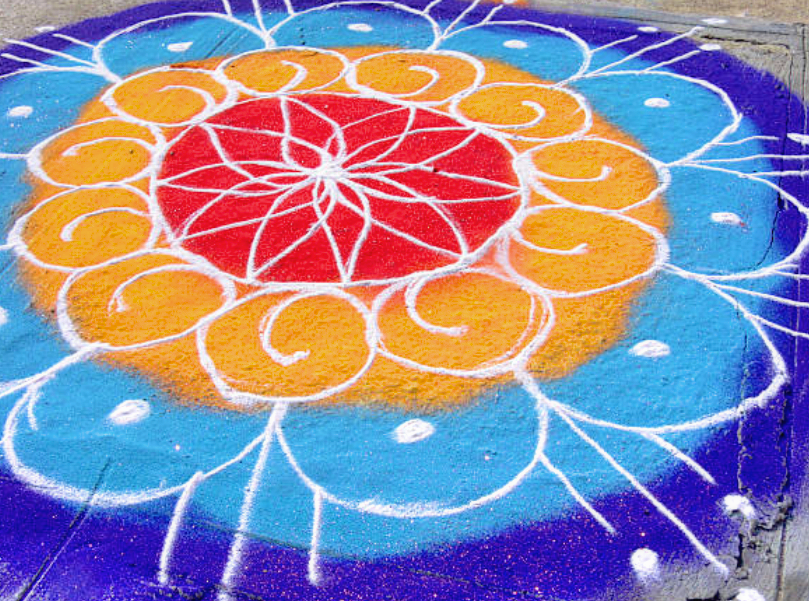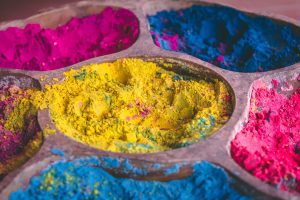- 833-265-6771
- [email protected]
- Mon - Fri: 8:00 - 5:00 EST

Immerse yourself in the fascinating world of Rangoli Art, a vibrant cultural treasure of India that’s rich in history and symbolism. The term “Rangoli” stems from two words—“rang,” meaning color, and “aavalli,” signifying a row of colors.
As the name suggests, this art form beautifully marries color and design, serving as a decorative and spiritual expression during festivals and celebrations.
The role of Rangoli extends beyond aesthetics and is seen as a harbinger of good luck in many parts of India. This captivating, ever-evolving art form lends itself to a plethora of therapeutic benefits, as you’ll soon discover.
Rangoli art, with its myriad hues and intricate patterns, has been a part of Indian culture for centuries. Traces of these decorative designs can be found in ancient texts, indicating their significance in rituals and festivities.
Traditionally, Rangoli was drawn by women who would rise early in the morning to sweep their front yards and draw these geometric patterns using rice flour, a symbol of prosperity.
This folk art is as diverse as the country itself, varying from region to region. While it’s called Rangoli in the south, it’s known as Alpana in West Bengal, Mandana in Rajasthan, and Kolam in Tamil Nadu. Despite the different names, the underlying essence of spreading joy and warding off evil spirits remains constant.
Traditionally, Rangoli designs were crafted using natural color powders derived from turmeric, sandalwood, and indigo. With modernization, synthetic dyes have also found their way into the palette, giving artists a broader spectrum of colors to choose from.
Art, in all its varied and beautiful forms, has been a catalyst for healing since time immemorial. Whether it’s a meticulously crafted sculpture, vivid Rangoli art, or a simple doodle on a notepad, the act of creating art can provide a powerful therapeutic outlet.
It’s a unique language that communicates our deepest feelings and thoughts, sometimes more profoundly than words can express. Art therapy taps into this creative language, enabling individuals to explore emotions, manage stress, and foster self-awareness and personal growth.
By focusing on the process rather than the end product, art therapy helps individuals express themselves, reconcile emotional conflicts, and practice problem-solving skills. Rangoli, with its intricate process and vibrant expression, serves as an embodiment of the therapeutic power of art, perfectly illustrating the principles of art therapy in action.
Creating Rangoli art is a process steeped in tradition, mindfulness, and creativity. It begins with envisioning a design or choosing a traditional pattern. From geometric shapes and nature-inspired designs to deity representations, the choice is limitless.
Then, the process of carefully sketching the design on the ground using chalk or a white powder mixture forms the blueprint for the art piece.
Following the sketched guide, different color powders are gently poured to fill in the design. The pouring process can be both repetitive and precise, requiring a steady hand and concentration. It’s in this process that the magic happens.
The repetitive action of pouring the powder and watching the design come to life can be a meditative experience, promoting stress relief and relaxation. The mind is engaged in a creative task, helping to push aside daily worries and distractions.
The use of color plays a significant role in enhancing the therapeutic effects of creating Rangoli art. Different colors have different psychological impacts—blues are calming, reds are energizing, greens are soothing, and yellows are uplifting.
The play of colors in Rangoli not only makes the design visually appealing but also stimulates emotional responses, promoting a sense of happiness and peace.
Lastly, the symmetry in Rangoli art ties the entire creation together, bringing about a sense of balance and harmony. The human mind finds symmetry comforting, and working to achieve it in the design can have a calming effect.
The act of focusing on maintaining balance and symmetry across the design allows for mindfulness and concentration, further promoting relaxation and stress relief.
The process of creating Rangoli art, with its focus on repetition, color, and symmetry, provides a unique therapeutic experience. It allows individuals to engage their minds in a productive and creative task, promoting stress relief, mindfulness, and a sense of satisfaction and achievement.
It’s more than just an art form; it’s a journey into a tranquil world of colors and patterns that can provide mental and emotional balance.
Starting your own Rangoli practice can be a rewarding journey that merges creativity, mindfulness, and cultural appreciation. Whether you’re an experienced artist or someone who simply loves colors and patterns, creating Rangoli art can offer a unique sense of satisfaction and calm. Here’s how you can start:
Creating Rangoli begins with deciding on a design. You can opt for traditional patterns or create your own unique designs, incorporating elements that resonate with you personally. The design is usually symmetrical and often represents nature or religious motifs.
Once your design is decided, it’s time to sketch it onto your chosen surface. Using chalk or a white powder mixture, you can outline your design, creating a blueprint to follow.
The filling process is where the real color comes in. Here, you gently pour your chosen color powders onto the sketched design, bringing it to life bit by bit. It’s crucial to be patient and take your time, allowing the process to become a mindful, meditative practice.

The primary material needed for Rangoli is color powder. This can be sourced from reliable providers like Color Powder Supply. They offer a wide range of vibrant, safe, and environmentally friendly color powders that are perfect for your Rangoli practice.
Additional materials include a tool for sketching your design (chalk or white powder mixture works well), and a flat, smooth surface to create your Rangoli. It’s also beneficial to have a reference image or pattern, especially if you’re a beginner.
Traditionally, Rangoli is practiced during festivals and special occasions in India. However, in your personal practice, you’re free to create whenever you feel inspired or in need of some therapeutic art time.
As for where to practice, Rangoli is typically done at the entrance of a house or in courtyards as a warm welcome to visitors. But in your practice, it could be any open space—your living room, backyard, or even a local park. Just remember to respect public spaces and local regulations if you choose a community area.
Starting your own Rangoli practice is not just about creating art but also about embracing a mindfulness exercise that celebrates color, culture, and creativity. Remember, there are no hard rules.
The most important thing is to enjoy the process, let your creativity flow, and let the act of creating Rangoli art soothe your mind. As you embrace this practice, you’ll find yourself on a vibrant journey of personal exploration and relaxation.